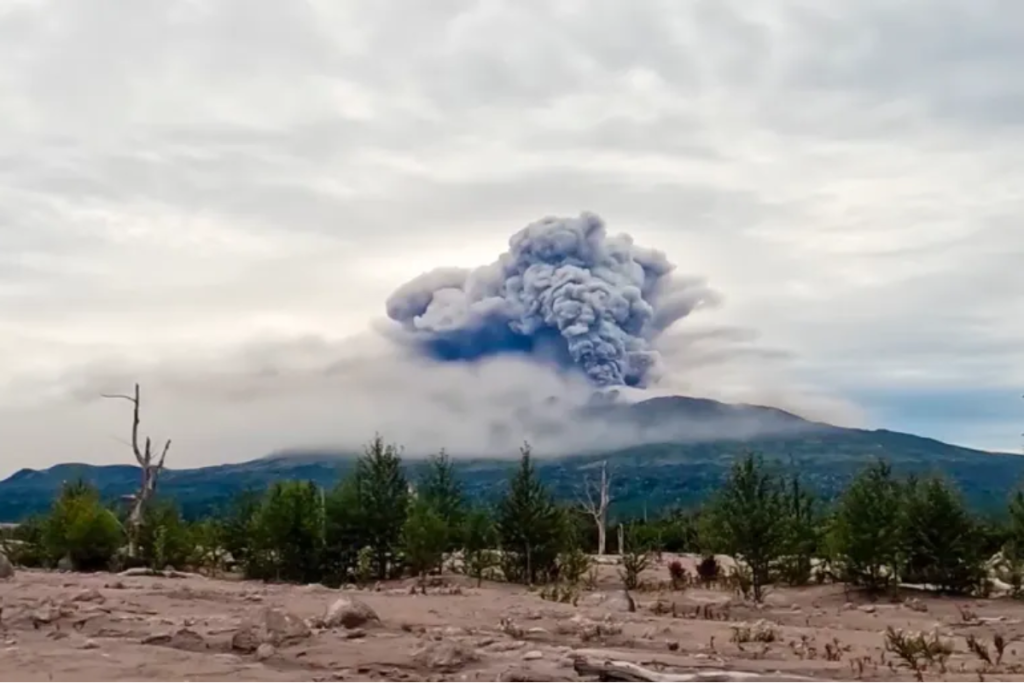
August 19, 2024 – In a dramatic display of the Earth’s geological power, the Kamchatka Peninsula in Russia has recently experienced a significant earthquake and a simultaneous volcanic eruption. This remote region, known for its seismic and volcanic activity, has once again reminded the world of the raw forces at play beneath the Earth’s crust.
A Powerful Earthquake Strikes Kamchatka
On August 18, 2024, at approximately 10:15 AM local time, a powerful earthquake with a magnitude of 7.4 struck the Kamchatka Peninsula. The epicenter was located offshore, about 50 kilometers southeast of Petropavlovsk-Kamchatsky, the region’s largest city. The quake was felt across the peninsula, shaking buildings and causing widespread alarm among residents.
The Russian Academy of Sciences’ Geophysical Service reported that the earthquake occurred at a depth of 30 kilometers beneath the ocean floor. Although there were no immediate reports of casualties, authorities have issued warnings of potential aftershocks and advised residents to stay away from vulnerable structures.
Immediate Aftermath and Response
In the wake of the earthquake, emergency response teams were quickly mobilized to assess the damage and ensure the safety of the local population. Despite the intensity of the quake, preliminary reports indicate that structural damage in major urban areas has been minimal, thanks in part to the region’s robust building codes designed to withstand seismic activity.
The Russian government has deployed additional resources to the area, including medical teams, rescue workers, and engineers to assist in damage assessment and recovery efforts. Local authorities have also set up temporary shelters for those who may need to evacuate their homes due to structural concerns or the risk of aftershocks.
Volcanic Eruption Adds to the Drama
Adding to the dramatic events, the Shiveluch volcano, one of Kamchatka’s most active volcanoes, erupted just hours after the earthquake. The eruption sent a plume of ash and gas soaring up to 10 kilometers into the sky, prompting aviation warnings across the region. Volcanologists had been monitoring increased activity at Shiveluch in the days leading up to the event, but the timing of the eruption so soon after the earthquake has raised concerns about the potential interplay between seismic and volcanic activity.
Shiveluch, located in the northern part of the Kamchatka Peninsula, is one of the most active volcanoes in Russia, with a history of violent eruptions. The current eruption has forced the evacuation of nearby settlements, and authorities have issued a red alert for aviation, warning of potential ashfall that could disrupt air travel across the region.
Impact on Local Communities
The twin natural disasters have significantly impacted local communities in Kamchatka. While the region is no stranger to both earthquakes and volcanic eruptions, the simultaneous occurrence of these events has heightened fears among residents. In the town of Ust-Kamchatsk, located near the Shiveluch volcano, residents reported feeling the ground shake violently during the earthquake, only to witness the sky darken with ash a few hours later.
Local businesses and schools have temporarily closed as a precautionary measure, and residents are being advised to stay indoors to avoid inhaling volcanic ash. The ashfall poses a significant health risk, particularly for those with respiratory conditions, and can also cause damage to crops and contaminate water supplies.
Monitoring and Future Precautions
Geologists and volcanologists are closely monitoring the situation in Kamchatka. The Russian Academy of Sciences has increased its surveillance of both seismic and volcanic activity in the region to better predict any further developments. While aftershocks are expected in the coming days, the possibility of additional volcanic eruptions cannot be ruled out.
Experts are particularly focused on understanding the connection between the earthquake and the subsequent volcanic eruption. While it is not uncommon for seismic activity to trigger volcanic eruptions, the specific dynamics of this relationship remain an area of active research.
Historical Context: Kamchatka’s Volcanic and Seismic Activity
Kamchatka is part of the Pacific Ring of Fire, a region known for its frequent earthquakes and volcanic eruptions. The peninsula is home to more than 300 volcanoes, 29 of which are active. The region’s volcanic activity is driven by the subduction of the Pacific Plate beneath the North American Plate, creating the conditions for both powerful earthquakes and explosive volcanic eruptions.
Historically, Kamchatka has experienced some of the most significant volcanic eruptions in recorded history. The 1956 eruption of the Bezymianny volcano, for example, was one of the largest in the 20th century, dramatically reshaping the landscape and leading to widespread ashfall across the region.
A Region on Edge
As the people of Kamchatka continue to grapple with the aftermath of the earthquake and the ongoing volcanic eruption, the region remains on high alert. The Russian government and scientific community are working tirelessly to ensure the safety of the population and to better understand the geological forces at play.
For now, the world watches as Kamchatka, a land of fire and ice, once again reminds us of the unpredictable and powerful forces of nature.

Dwayne Paschke specializes in writing, management, development, design and Search Engine Optimization. Although he has worked for 8 years in the industry, he never found an ideal person to work with as a partner. Later, he found Sebastian Pearson, and they both found specific understanding between them. Both of them divided their tasks in this project and are running this venture successfully.
